The Plextor M8Pe (512GB) SSD Review
by Billy Tallis on December 14, 2016 9:00 AM ESTATTO
ATTO's Disk Benchmark is a quick and easy freeware tool to measure drive performance across various transfer sizes.
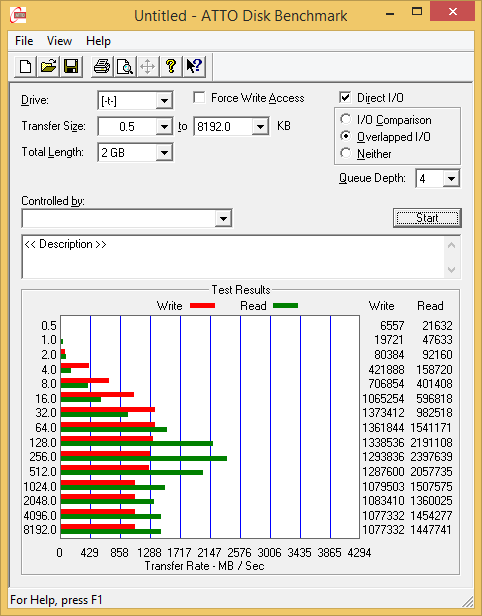 |
|||||||||
The two configurations of the M8Pe ramp up identically as transfer size increases, but the M8PeGN without the heatsink starts throttling right after it hits full performance.
AS-SSD
AS-SSD is another quick and free benchmark tool. It uses incompressible data for all of its tests, making it an easy way to keep an eye on which drives are relying on transparent data compression. The short duration of the test makes it a decent indicator of peak drive performance.
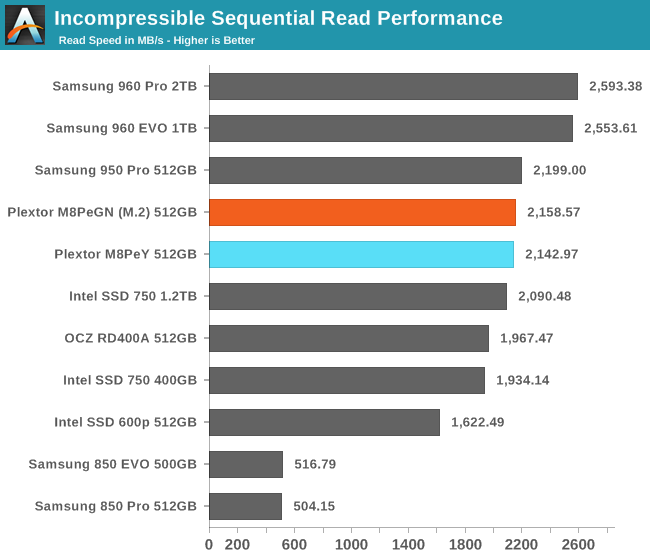
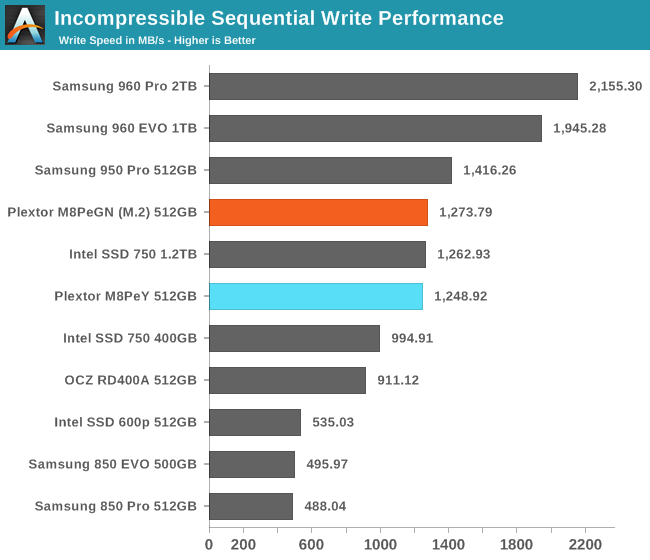
The M8Pe delivers short-duration sequential speeds that are second only to Samsung's PCIe SSDs, and tied with the much larger 1.2TB Intel SSD 750.
Idle Power Consumption
Since the ATSB tests based on real-world usage cut idle times short to 25ms, their power consumption scores paint an inaccurate picture of the relative suitability of drives for mobile use. During real-world client use, a solid state drive will spend far more time idle than actively processing commands.
There are two main ways that a NVMe SSD can save power when idle. The first is through suspending the PCIe link through the Active State Power Management (ASPM) mechanism, analogous to the SATA Link Power Management mechanism. Both define two power saving modes: an intermediate power saving mode with strict wake-up latency requirements (eg. 10µs for SATA "Partial" state) and a deeper state with looser wake-up requirements (eg. 10ms for SATA "Slumber" state). SATA Link Power Management is supported by almost all SSDs and host systems, though it is commonly off by default for desktops. PCIe ASPM support on the other hand is a minefield and it is common to encounter devices that do not implement it or implement it incorrectly. Forcing PCIe ASPM on for a system that defaults to disabling it may lead to the system locking up; this is the case for our current SSD testbed and thus we are unable to measure the effect of PCIe ASPM on SSD idle power.
The NVMe standard also defines a drive power management mechanism that is separate from PCIe link power management. The SSD can define up to 32 different power states and inform the host of the time taken to enter and exit these states. Some of these power states can be operational states where the drive continues to perform I/O with a restricted power budget, while others are non-operational idle states. The host system can either directly set these power states, or it can declare rules for which power states the drive may autonomously transition to after being idle for different lengths of time. NVMe power management including Autonomous Power State Transition (APST) fortunately does not depend on motherboard support the way PCIe ASPM does, so it should eventually reach the same widespread availability that SATA Link Power Management enjoys.
We report two idle power values for each drive: an active idle measurement taken with none of the above power management states engaged, and an idle power measurement with either SATA LPM Slumber state or the lowest-power NVMe non-operational power state, if supported.
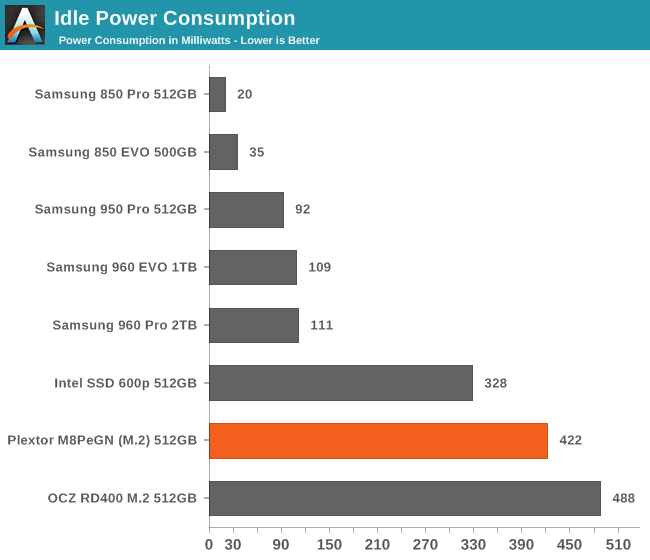
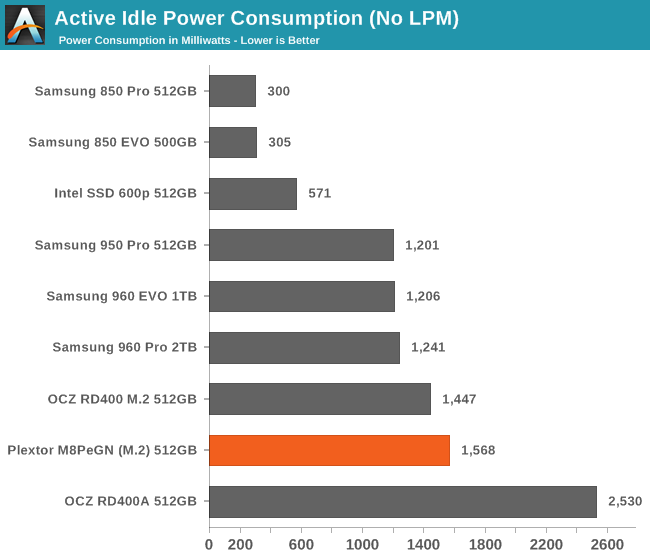
Samsung is still the only PCIe SSD vendor that has made significant progress with idle power management. Even when put into the lowest power state, The M8Pe (and the Intel 600p and OCZ RD400) consume more power than most idle SATA drives with no power saving features engaged.
When NVMe power management is not supported or not enabled, the Plextor M8Pe doesn't look too bad by comparison, as even Samsung's PCIe drives idle at 1.2 W compared to the M8Pe's 1.5 W.










64 Comments
View All Comments
MrSpadge - Wednesday, December 14, 2016 - link
Considering your ADATA is quite small at just 1 GB, these will be a noticeable upgrade. Starting from a 1 TB drive, though, will likely not be noticeable (unless you're running significantly I/O limited workloads).Ratman6161 - Wednesday, December 14, 2016 - link
Assuming you meant 1TB rather than 1 GB. Can the majority of humans tell the difference? I can't speak to what the majority can tell but I can state my personal experience. My main system drive is currently a 250 GB 850 EVO. I've also had an opportunity to (though briefly) to use a system with a 950 Pro in it. For anything that I personally do, no, I could not tell the difference. Of course I don't do anything particularly storage intensive either. I'm most concerned with boot up time and how fast programs open, etc.To me, given pricing as it exists today, there are only really three drives mentioned that I would even think about. Assuming you need an m.2 form factor (which I currently don't so will stick with my 850 EVO) 960 Pro if you want the best performance available, 960 EVO if you want great upscale performance at a reasonable price, and the Intel 600 P if you don't need great performance but do need the M.2 form factor. But if the prices change it may well be possible to just buy the cheapest in the particular performance class you want.
sinPiEqualsZero - Wednesday, December 14, 2016 - link
Thanks to both of you. I did mean 1 TB, my bad. I have one of the DAN cases and will be building it out in Jan/Feb, that's why I asked. Looks like I'm sticking with SATA unless prices come down. Mayyyyybe the 960 EVO.Bruce427 - Friday, December 16, 2016 - link
** [get] the Intel 600 P if you don't need great performance but do need the M.2 form factor. **Currently, the MyDigital BPX NVMe drives will significantly outperform the 600Ps, and for less money.
They also use MLC flash and have a full 5 year warranty.
I have several 950 Pros. I recently bought/installed a 240GB BPX for benchmarking/testing and at $107.85 (what I paid) it's a great little drive.
Death666Angel - Sunday, December 18, 2016 - link
MyDigital doesn't have European retailers it seems? At least nothing but one listing in Germany for a BP4. :/ddriver - Saturday, December 17, 2016 - link
No, 99% of the use cases won't show tangible improvement. SATA SSDs are already fast enough to eliminate storage as a bottleneck. You may have TB\sec and it will still not make a difference if the bottleneck is somewhere else.peterfares - Wednesday, December 14, 2016 - link
Why is there a power connector on top?Billy Tallis - Wednesday, December 14, 2016 - link
I think it's just an alternate power delivery path for situations where the PCIe slot doesn't provide enough. I didn't bother using it, since I was measuring power consumption through the PCIe slot.XabanakFanatik - Wednesday, December 14, 2016 - link
When are you going to redo new drives like the 960 Pro/Evo and RD400 with the angelbird wings PX1 so we can see how and if oerformance improves with a heatsink?Last year AT had redone benches from the 950 pro this way.
Billy Tallis - Wednesday, December 14, 2016 - link
At the moment, I'm more concerned with putting together an updated test suite for 2017. Once that's ready and everything's been re-tested, I'll go back and test the 960s with a heatsink. It'll probably be February, and probably won't be worth an article of its own.We already have the RD400A results in Bench, and the one thermal pad behind the controller that it uses was enough to eliminate thermal throttling (with one possible exception).